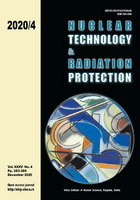
ASSESSMENT OF ENVIRON MENTAL RADIO ACTIVITY AND HEALTH HAZ ARD AT STARA PLANINA RE GION

Vol.
XXXV, No. 4, Pp. 283-386
December 2020
UDC 621.039+614.876:504.06
ISSN 1451-3994
Pages: 354-360
Authors: Slavko D. DimoviŠ, Boris B. Vakanjac, Ivana V. JeliŠ, Milena G. RikaloviŠ, Vesna R. RistiŠ Vakanjac, and Radoje D. BankoviŠAbstract
The aim of the study was to evaluate the potential risks of radiation near abandoned uranium mines, tailing dumps, or uranium deposits on Mountain Stara Planina, Serbia. For risk assessment several parameters were determined: radium equivalent activity, Raeq, external hazard index, Hex, gamma radiation absorbed dose rate, D, annual effective dose on background outdoor gamma exposure, AEDoutdoor, and excess lifetime cancer risk, ELCR. Obtained results showed that all the samples, except one, have the Raeq value up to two times higher than the reference limit. The Raeq of the sample from the Mezdreja mine tailings was increased by almost eight times. The value of Hex followed the same pattern as Raeq. All the investigated localities have increased D values, while all the samples have shown the moderately low AEDoutdoor, except Mezdreja mine tailings that have 5.5-2.8 times higher dose relative to the world's average. ELCR at the Mezdreja mine tailings is 4.58 times higher than the world's average of 1.45·10-3. In the context of human activity in the area of Stara Planina such as different kinds of tourism, livestock breeding, dairy products, and herbal manufacturing, etc. there is a need for detailed analysis in order to evaluate potential human exposure and health impacts.
Key words: natural radioactivity, environment, health, hazard, risk assessment
FULL PAPER IN PDF FORMAT (490 KB)